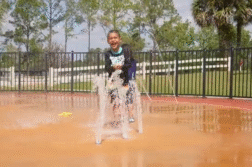JACKSONVILLE, Fla. (Ivanhoe Newswire) – Whether it’s the brain, spine, joints, tissues, or organs, 10 million people will get an MRI, or magnetic resonance imaging. It’s a diagnostic imaging procedure that uses a powerful magnet, radio frequencies and a computer to produce images for doctors to get a detailed look at what’s happening inside the body. But for children, getting an MRI can be downright terrifying, until now. Portable MRI
Pediatric neurosurgeon at Wolfson Children’s Hospital, Dr. Alexandra Beier, explains, “Unfortunately, a lot of the patients that we take care of are either really small or they’re really sick.”
So sick that Dr. Beier says, moving these children to a room with an MRI can be risky.
“There’s a lot of patients, especially the cardiac patients, where they cannot physically be moved, and even our severe traumatic brain injury patients where you know every time you move them, you’re risking increased pressure to their brain,” Dr. Beier further explains.
The standard MRI looks like a tunnel – it’s big, immobile and often causes anxiety and discomfort for kids. But there’s a new smaller, portable MRI machine.
Dr. Beier demonstrates to Ivanhoe, “This was one of the first scans we used the hyper fine swoop MRI for. And it was very nice because the patient was very small and we did not want to transport him because he was having seizures and there was a lot of risk with transporting him. So, we’re able to do it right at the bedside.”
The magnet in the mobile unit is less powerful.
“It’s basically as strong as a refrigerator magnet,” Dr. Beier mentions.
The time it takes is cut down from an hour to 35 minutes.
Dr. Beier makes clear that, “It would never replace a full MRI, it would just add to the ability to do the information at the bedside.”
Doctors believe that the portable MRI will have far-reaching implications beyond pediatrics. The aim is enhance access to diagnostic imaging for patients of all ages.
Contributors to this news report include: Marsha Lewis, Producer; Roque Correa, Videographer & Editor.
To receive a free weekly e-mail on medical breakthroughs from Ivanhoe, sign up at: http://www.ivanhoe.com/ftk
Source:
https://www.ncbi.nlm.nih.gov/books/NBK588376/
MEDICAL BREAKTHROUGHS
RESEARCH SUMMARY
TOPIC: ON THE MOVE: PORTABLE MRI FOR CHILDREN
REPORT: MB #5263
BACKGROUND: A portable MRI is a new technology that converts MRI signals into intricate photos of the brain. It’s through the coupling of artificial intelligence (AI) and MRI mechanics that impactful images can be captured. With the portable MRI featuring a smaller magnet, this allows individuals to be in proximity of the MRI – which is very beneficial for young patients longing to see loved ones while they scan. The introduction of this technological advancement is timely as almost 40% of patients with brain injuries undergo complications during transport to a full MRI scanner.
DIAGNOSING: The portable MRI has been found to successfully diagnose strokes and expose brain blood clots as little as 4mm in size. In a study conducted by Yale New Haven Hospital, 50 patients diagnosed with an ischemic stroke underwent brain imaging using a pMRI. In 90% of the patients, the system accurately detected an ischemic stroke had occurred in said individuals.
(Source: https://physicsworld.com/a/portable-mri-diagnoses-stroke-at-the-patient-bedside/)
NEW TECHNOLOGY: In 2022, the Swoop portable MRI device made its debut at the University of Minnesota Medical Center. It’s been used in the emergency room, post-anesthesia settings, and the intensive care unit. With Swoop, once you scan, AI begins to examine and convert brain images to best represent inward changes arising in the individual’s medical track. This system primarily serves two groups — pediatric and neuro-ICU patients.
(Source: https://www.mddionline.com/rd/how-hyperfine-developed-worlds-first-portable-mri-machine)
FOR MORE INFORMATION ON THIS REPORT, PLEASE CONTACT:
Emily Sharpe
If this story or any other Ivanhoe story has impacted your life or prompted you or someone you know to seek or change treatments, please let us know by contacting Marjorie Bekaert Thomas at mthomas@ivanhoe.com




